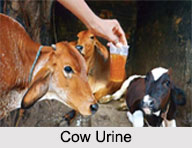 Cow Urine is used for purposes of therapy in traditional Indian medicine and is called "Gomutra". It has also been used for different purposes in their rituals as well as daily lives from ancient time.
Cow Urine is used for purposes of therapy in traditional Indian medicine and is called "Gomutra". It has also been used for different purposes in their rituals as well as daily lives from ancient time.
Cow urine is always very pure which makes other contents purified. The properties of Gomutra is mentioned in old Sanskrit script:
"gavyam pavitram ca rasayanam ca pathyam ca hrdyam balam buddhi syata aayuh pradam rakt vikar hari tridosh hridrog vishapaham syata"
It means that "Cow urine, Panchagavya is great elixir, proper diet, pleasing to heart, giver of mental and physical strength, enhances longevity. It balances bile, mucous and airs. Remover of heart diseases and effect of poison".
Chemical Composition of Cow Urine
The cow urine has been analyzed and it has been found that different chemical components of cow urine are responsible for its various properties. They are discussed below:
•Nitrogen: It removes blood abnormalities and toxins. Nitrogen is a natural stimulant of urinary tract that activates the kidneys and has diuretic property.
•Sulphur: It supports movement in large intestine and cleanses the blood.
•Ammonia: It stabilizes bile, mucous and air of the body. It also stabilizes blood formation.
•Copper: It prevents the formation of unwanted fats.
•Iron: It maintains body balance and helps in production of Red Blood Cells and haemoglobin. It stabilizes the working capacity.
•Urea: It has effect on urine formation and removal of body toxins. It has germicidal properties.
•Uric acid: It removes heart swelling or inflammation. It is also diuretic and thus helps in removing toxins.
•Phosphates: Aids in removing stones from urinary tract.
•Sodium: Purifies blood and antacid in nature.
•Potassium: It cures hereditary rheumatism. Potassium increases appetite and removes muscular weakness and laziness.
•Manganese: It is germicidal, stops growth of germs and prevents decay when gangrene occurs.
•Carbolic Acid: It is also germicidal and stops growth of germs and decay due to gangrene.
•Calcium: It is Blood purifier, bone strengthener and have germicidal effect.
•Salt: It decreases acidic content of blood and is also germicidal.
•Vitamins: Vitamin B is an active ingredient for the energetic force of life and prevents nervousness and thirst. It strengthens the bones and increases reproductive power.
•Lactose: It gives satisfaction, strengthens heart, removes thirst and nervousness.
•Enzymes: Makes healthy digestive juices and increases immunity.
•Water: Water is life to all the creatures. It maintains fluidity of the blood and maintains body temperature.
•Aurum: It is germicidal and increases immunity power. Aurum is highly anti-biotic and anti-toxic.




















